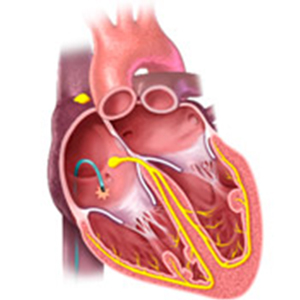Download this patient information sheet

Catheter ablation is a treatment for people who desire a cure for their arrhythmia rather than take drugs. Ablation uses one of 2 different technologies:
An EP study is first performed to find out the cause of your arrhythmia, if it can be treated by ablation and where the “short circuit” is located.
Upon arrival to the lab, you will be greeted by the nurses who will be looking after you. Once you get comfortable on our table, you will be attached to a blood pressure machine and heart monitor. The use of conscious sedation or general anesthesia is decided on a case-by-case basis. The skin will be cleaned and you will be covered by sterile drapes. Local anesthetic (similar to “dental freezing”) will be injected into the skin in the groin and/or under the left collar bone. Small hollow tubes will be inserted into your veins.
Through these tubes, small wires are advanced into your heart and used to try to turn on your tachycardia, take measurements and establish the location of the “short circuit”. After that, a special ablation wire is used to deliver the heat or cold therapy.
Often, a number of burns or freezes must be given to completely address the problem. We then wait about 30 minutes and then test to make sure the problem is gone. We then pull out all the wires and press on the site for 5-10 minutes. You will usually be required to lie flat for 4 hours to allow the site to heal.
After catheter ablation, most people are truly cured but in a small percentage of people, the problem can come back and need another ablation procedure. Obviously, curing you of one problem does not prevent you from developing a new unrelated heart problem.
As for all medical procedure, there are risks. The overall risk of a complication is only 1-3% and include:
Q. How long will my ablation take?
A. On the average, 2-4 hours (depending on the complexity of the problem – the doctor will discuss this with you)
Q. Does ablation damage my heart?
A. The size of the lesion is only a few millimeters. It will not affect the overall function of your heart.
Q. Which doctors would perform the ablation?
A. Dr Sy will be in charge and he would supervise the ablation. He works with a team of doctors, nurses and technicians to make sure the ablation is done properly and safely.
Q. When can I go home after the procedure?
A. In the vast majority of cases, you will need to stay overnight. You will be reviewed in the morning prior to being discharged.
www.hrsonline.org (Heart rhythm society)